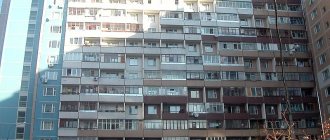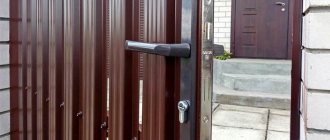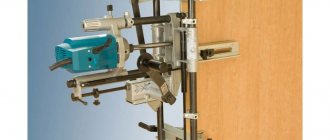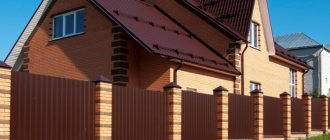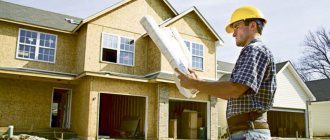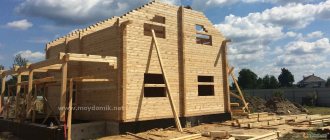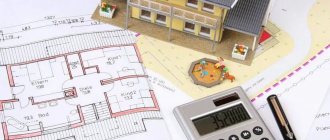Today, the technology of frame houses in Moscow is becoming increasingly popular. They are built not only as dachas, but also used for permanent residence. If initially such buildings were built according to a standard project that did not provide for expansion, today there are projects of frame-modular houses, the design of which initially included the ability to complete the construction of 1-2 modules. Buying a growing house is much more profitable than buying an ordinary one and then trying to finish it.
Features of the technology
- A cheap and practical pile-screw foundation is being erected. It is well suited for such buildings and allows for expansion if necessary. The piles are easily connected to each other by screwing the new module and additional strapping into place. This option is preferable, but other types of foundation are also possible.
- Decorated mortgages are created in the walls where the joint is expected. It looks very simple in words, but a technologically growing frame house is a very complex structure. Its development should be carried out by specialists.
- There is no need to dismantle existing walls with windows and doors. Initially, they are designed as sliding structures that fit harmoniously into the new parts of the building.
- No roof reconstruction required. The construction of frame modular houses of this type involves the use of a “breaking roof” - new sections are not built up to the existing one, but are mounted below or above the base one. If you plan to build a second floor, then some sections of the roof are simply dismantled.
- On average, completing an additional section of a growing modular house takes from 10 to 30 days. Which is fast enough.
Compact and comfortable home
Dmitry had a dacha - six acres. But he was tired of the “dacha comfort” of the gardening community. And so he decided to get rid of it and create a cozy family nest in another place and on a larger territory.
The search for a suitable site lasted two years and we were already planning to find something simpler, but suddenly we came across a small advertisement in the newspaper. Arriving at the place, he saw a nice flat plot not far from Moscow in an old-fashioned cozy place. And so in 2000 he acquired a magnificent plot with luxurious trees.
Project
For future successful construction, it is important to correctly compile T3. The whole family thought long and carefully about the house project. We drew the size of the house, the necessary premises, and thought through the style of the interiors and exteriors. Structural and planning materials were developed. While looking through magazines, Dmitry came across the project of the Edna house by Vitaly Yurchenko. It served as the basis for the design of the future house as it coincided with many of the family’s aesthetic wishes. So the total area of the house was 154.1 m. kV.
First of all, the site was divided into an official zone and a private one. The living room, technical rooms and hallway face the main façade. The private area includes a kitchen with access to the street and grandma’s bedroom.
On the second floor of the house there are 3 bedrooms, two children's and a parent's room, as well as a bathroom with a bathtub and a storage room. In addition, a convenient attic of 40 m/2 was created for necessary and unnecessary things. Children like to gather there, climbing up the folding stairs.
As a foundation, we chose a reinforced concrete strip to a freezing depth of + 10 cm. A monolithic floor with a thickness of 160 mm was poured on top as the floor of the first floor. This is cheaper than installing standard slabs with a crane. And there is no need to adjust the size of the house to fit them.
The walls were made of 300 mm foam blocks + 50 mm insulation + 120 mm facing bricks. straw color.
The ceiling of the first floor was also poured with concrete. The height of the first and second floors is 290 cm. The staircase to the second floor has two flights, each 90 cm wide.
Soft tiles were used as roofing. It is coated with an abrasive that prevents snow from sliding off the roof. Despite the angle of 45 degrees, not a single snowdrift has slipped off the roof over several years of operation. It is cheaper in cost than metal tiles (taking into account the characteristics of the roof, there is a lot of waste). But when installing it, you must strictly follow the technology. This roof, unlike metal tiles, does not breathe, and if ventilation gaps are not made, ventilation ridges and aerators are installed incorrectly, then the end of the roof will inevitably and quickly occur. The cost of the roof including materials, roughing and finishing work was $13,000.
Construction of the house began in March 2002. And in August a box with a roof was built, doors and windows were installed. At this point the house was left to stand until next year. In winter, the temperature in the house was maintained at 5 degrees Celsius with electric radiators.
The following year, the builders completed the basic finishing and laid all the necessary communications. Having basically prepared the house for living. Then, over the course of several years, Dmitry’s family slowly settled into the house.
Home decoration
On the first floor, ceramic tiles were used as flooring. It’s very convenient - you can go out into the garden without changing clothes, and if it gets dirty, you can easily wash it. Quickstep laminate flooring was installed in the bedroom. On the second floor, the floor is also laminate.
The walls were done simply - plastered, puttied and painted. The ceiling was puttied and painted. Eurocam-slimbrik decorative stone was used to decorate the arches and fireplace in the living room.
We purchased a Spanish Invicta firebox for the fireplace. Ceiling beams made of polyurethane. Dmitry also purchased a Czech wood-burning boiler to heat the house. After this, heating costs decreased many times over.
There are no complaints about all façade and interior finishing work during operation. Everything is holding up well and there are no cracks anywhere. The construction of the house went well and without errors. The key to success during the construction of a house, according to Dmitry, is a competent technical specification and a project with good detail.
The house turned out to be very comfortable, cozy and warm. For 150 m/2 12 kW of electricity is enough.
Fireplace
The house had a brick duct for the chimney. Therefore, Dmitry made the fireplace himself. I ordered 1mm thick stainless steel pipes. Then the pipes were installed in the chimney, sprinkled with perlite sand and covered with bricks. Fireplace insert - Invicta Selenik 700 is inexpensive, high quality and has a good design.
After installing the pipes, the stove was placed on bricks, connected to the chimney and heated. After that, they began to make a box of foam blocks around the stove with foil thermal insulation installed inside. The top was lined with Eurocam decorative stone.
At that time, a stove with a chimney cost $1,000. At the same time, everything works perfectly, and the stove lights with one match, does not smoke and gives good heat.
Boiler room
The house has a boiler room with two boilers, an electric one hanging on the wall and a wood-burning one on the floor. At night the house is heated with electricity and during the day with wood. But usually after night there is enough heat for the whole day - the house slowly cools down.
Hot water comes from a 100 liter electric storage boiler. It is installed in a storage room on the 2nd floor.
He made the heating wiring using metal plastic. From one point, pipes fan out over the shortest distance to each radiator, both on the first and second floors. The pipes are located in the floor screed. Distilled water is used as the liquid.
Sewerage
The waste goes into the sewer system, and from there into the Topas bioseptic tank. It is located 2 meters from the side facade. The system is very reliable, there is no smell and does not require extensive maintenance. After purification, the water from it goes into the well before the sand.
Basic materials spent on construction
- Expanded clay concrete blocks purchased - 58.7 m/3 size (300x200x600);
- Facade facing bricks (including fireplace pipes) – 16.3 m3;
- Red hollow brick (for facade plaster) – 7.3 m3;
- Concrete preparation for the foundation h=100 mm. grade B7.5 – 8 m/3;
- Concrete for the foundation grade B15 – 46 m/3;
- Monolithic floor and ceiling ceilings of the 1st floor - 16.6 m/3 and 2nd floor - 12.7 m/3 made of B15 concrete with a thickness of 160 mm. – 29.3 m/3.
Posted by a member of the “House and Dacha” forum Zikkurat Editor: Adamov Roman
Several examples of successful house layouts
An example of the layout of a one-bedroom house Source certy.ru
Original house layout with a round living room Source ecoteploiso.ru
Layout of a house where the living room, kitchen and dining room are combined Source centermira.ru
Layout of a two-bedroom house Source roomester.ru
Layout of a large house with a terrace Source sitysun.ru
Example of second floor layout Source tech.smart-wood.lv
Advantage 2 - you can use cheap fill-in insulation
Why don't we use sawdust as insulation? Or why hasn’t ecowool captured the insulation market yet?
They settle. You need to be able to “add” insulation on top of the walls and under the window space.
The key feature of this house design is that you can access all the exterior walls from the TOP. By taking apart the overhang trim, you can easily see the level of insulation and add more.
In addition, we can initially raise the walls above the level of the roof insulation and pour in insulation taking into account subsidence.
Which house project to choose: one or two floors
The possibilities of modern design of residential buildings make the name “one-story house” conventional. The house construction plan may include the equipment of the basement floor and the construction of an attic. A cottage with such extensions will turn out to be three-level in the design of a one-story house. The attic and ground floor cannot be called floors, but such premises will make housing more comfortable and increase the usable area of the house.
On the ground floor they usually equip the economic sector, install sports equipment, and install communications. Here you can equip a boiler room and make a garage. The attic can be equipped with bedrooms and children's rooms.
An example of the layout of a house with a ground and attic floor Source medicroslavl.ru
If you are not attracted to a home with additional levels, you should plan the rooms with efficient use of space in mind. The house must provide premises for all family members, and the kitchen and dining room must be combined. The same applies to the toilet and bathtub. The construction of low partitions and columns will help to delimit the zones.
A two-story house is being built for a large family. Living rooms for household members are planned on the second floor. On the first floor, a living room, kitchen, and guest bedroom are set up. When several generations live together, the older family members are assigned rooms downstairs. Bathrooms on the floors are placed one above the other. This makes communications easier.
If you want to install autonomous heating, the boiler room is located near the kitchen, in the basement or garage.
The choice of which house to build, two-story or one-story, should be based on the size of the plot. If you have a large family and a small plot, it is better to give preference to a two-story structure. In such a house, you can allocate a personal room to each family member and at the same time save territory on the site.
An example of the layout of a two-story house Source centermira.ru
If the family is small, then a one-story house, even on a small plot, will be quite enough, because a two-story structure will cost much more.
When designing a house, they provide for the possibility of further expansion of housing.
Construction plan in rough strokes
I will be as brief as possible. For a better understanding, I will sprinkle plenty of pictures. Go.
Project
I’ll take as an example an American house project of 136 m2 (8x17 if without a terrace and 11x17 with it). Not the best example, but suitable for our purposes.
Project of a 4-room house with an area of 136 m2
The right half of the house is being built in the first stage, the left half is being built in the second. Or vice versa. Who likes it more? At the first stage we have a kitchen of about 12-16 m2. Almost the same bedroom. Pantry and bathroom.
On the second floor there is a large living room with kitchen. The kitchen is moved there as shown in the picture.
Columnar foundation. Rationale.
The slab is good, but our house should be placed on a site with almost any difference in height. Therefore, piles.
The driller arrives and the formwork is set up for the parts of the piles that stick out above ground level. A pile field is poured under the entire building site.
This is what a bored pile looks like with a pin for tying it with a board or timber.
As an option, you can use iron piles. The cost will be a little more expensive, but it will be quick. Personally, I am against it - there are serious disadvantages that we will not be distracted by.
A frame made of timber or boards is made on top of the piles.
Tying piles with boards or timber
We place floor joists on top of the trim according to the diagram from the project. We fill the ceiling under the first part of the house with insulation, cover it and hem it. We cover the rest of the space with osb or board.
Walls
We assemble the frame walls of the first part of the house strictly according to the design. No cladding - pure frame.
Cover with a roof
We collect farms. We make a slope on top of them. We call a specialist in PVC membranes. He will cook everything competently and reliably in a few hours.
We blow out or lay insulation.
After the whole house has a roof, you can let the frame stand in the wind so that the wood releases any remaining moisture.
Sheathing and internals
We sheathe the frame of the first part of the house and install windows, finishing the outside.
At this stage we get something like this:
A large canopy, 1/2 or 1/3 of the area under it is occupied by the house.
Interior work and housewarming
We lay insulation and install electrical wiring. We are finishing the bathroom. We are finishing the remaining rooms.
Housewarming
We are having a noisy housewarming party on the huge veranda. You can cover one side with film to reduce airflow.
Then we apply cosmetics and decorate our house so that it does not look unfinished.
We will repay the loan for the next 1-2-3 years. And without relaxing, we begin to wear the same 30-50,000 rubles. monthly not to the bank, but to the building materials base. Gradually or in spurts (as you like) we turn the remaining veranda into a house.
Is it really possible to build a house for a million with your own hands?
I think yes. With a bunch of assumptions and non-standard solutions in all areas: finance, design, wall material, finishing.
If not a million, then one and a half. By simplifying everything you can and reducing its area, you can settle in your home.
For those who are too lazy to read, I’ll briefly summarize the essence.
The idea is to make the house grow. At the start we make a foundation and a roof and build 50m2 under them. The rest turns into a terrace. We move in and pay off the loan to the bank for 1, 2, 3 years.
In the second stage, on the same foundation and under the same roof, instead of a terrace, the second part of the house is being completed. The total area of the house becomes 120-150 m2.
The meanings put into this house
I believe there is a solution to the housing problem for our people.
I want every family that has a man with a head and hands:
- built my house
- so that this is not a feat both in terms of money and time
- so that the house is comfortable and brings only joy, not problems
Why am I against an apartment with a mortgage:
- I don’t like mortgage slavery for 10-15 years.
- I don’t like that in the end I have to pay 2.5 times the cost of the apartment.
- I don’t like that the cost of materials for this concrete cage is 500-800 thousand.
The big goal is to make a house design that can be had for pennies. With a step-by-step plan, like in a Lego constructor. For people to live on their own land. So that they can decide for themselves how many children to plan. So that dad would raise his children and not work from morning to night for 15 years in slavery. So that the family has bright heads and health.
All this is missing in 15-story “human buildings”.
Please don't judge harshly. This is a concept. I'm just a handy technician with no construction experience. The idea can and should be supplemented and changed. All comments are welcome.
Let's create a real people's home together!
Three room house layout
Such housing can easily accommodate a family of three. It is necessary to equip two bedrooms and a living room.
From the hallway you can provide three exits at once: to the kitchen, to the bathroom and to the living room. Thus, the living room will be a passage room and from it you can access two bedrooms.
A 3-room house should have:
- corridor;
- hall;
- two bedrooms;
- kitchen;
- bathroom;
- vestibule.
If desired, a veranda or an additional porch with access from the kitchen can be built.
An example of the layout of a house consisting of three living rooms Source yurlkink.ru
What do we sacrifice and for what?
In order not to pay a mortgage worth several million. To avoid the risk of getting unfinished. For the sake of simplicity, which will come back to haunt you in a good way at the stage of life in this house. For all this we sacrifice:
- second floor
- classic “bird house” with a gable roof - instead a flat roof
- the idea of immediately moving into 150 m2 - for the first years you will have to live in the equivalent of a two-room apartment
We get a lot more, as we bypass a number of problems:
- There will be no long-term construction - you move in after building 50m2.
- You can't build a house on half a concrete foundation. It must be loaded evenly.
- There is no need to build a guest house or bathhouse, and then start building the main house.
- No scaffolding is needed to finish the façade of the second floor
- No specialists needed to build a roof
But the most important advantages are below:

